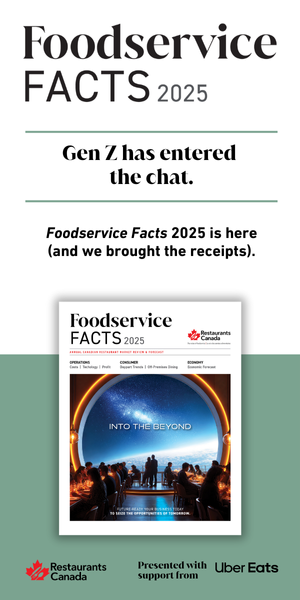Canada’s Trade Battle: The Story So Far on the Tariff War and its Impact on Restaurants
After months of escalating threats, then a last-minute reversal in February, President Trump finally followed through on imposing a sweeping 25 per cent tariff on Canadian goods, with a 10 per cent tariff on energy. While he reversed the policy just days later, providing an exemption for CUSMA compliant goods until April 2, Canada is not out of the woods.
As of the time of this writing in mid-March, Canada has taken a hard-line approach to the tariff dispute, imposing its own 25 per cent tariffs on $60B worth of U.S. goods, with the promise to expand that list to $150B worth of goods if the U.S. does not remove all tariffs by April 2. In addition, all provincial and territorial governments have stopped buying and selling U.S. alcohol products and are excluding U.S. firms from government contracts. This strategy by our government aims to strike the U.S. as strongly as possible in an effort to pressure them to remove the tariffs as quickly as possible. It enjoys strong support among Canadian consumers, which must be considered as we at Restaurants Canada develop our strategy.
It has been heartening to see the unity with which Canadians have responded to these threats, even as we gear up for a long period of economic uncertainty. Here are a number of ways this has impacted the restaurant sector:
Interprovincial trade is finally getting its day in the sun.
The rapid deterioration of Canada’s trading relationship with the U.S. has forced the government to look to grow its agreements with other markets, but it has also finally pushed Canada to rethink its protectionist internal trade policies.
While the Canada Free Trade Agreement has been in place for nearly 10 years, we have never seen this level of unified interest in actually liberalizing trade across provincial borders. Last month, Minister of Internal Trade Anita Anand announced that nearly all provinces and territories will move to allow the purchase of alcohol from other provinces, something that Restaurants Canada has been calling for for years.
We also saw commitments from Nova Scotia, British Columbia, Alberta and Ontario to strike mutual recognition agreements with other provinces willing to do the same. This is a big deal because it would tackle the core of interprovincial trade barriers—inconsistent regulations from province to province on things like first aid kits in trucks—rather than addressing each barrier individually.
Opening up the flow of goods, services and labour between provincial borders has the potential to add $200 billion annually to our economy. On the micro level, it would make it easier and less expensive for Canadian producers to diversify their supply chains and for foodservice businesses to source products from Canada.
There is still a lot of work left on this file, but it has certainly been a silver lining in the tariff war with the U.S. We should not waste this precious momentum. Restaurants Canada will be pushing hard to dismantle interprovincial trade barriers that stem the flow of goods the foodservice industry depends on.
The importance of strength and unity in the face of adversity.
Just as Canada is building its international relationships, Restaurants Canada has been busy building a network of policy makers, trade negotiators and other business and labour associations to get the latest information and amplify our advocacy. Our focus is to highlight the specific challenges the foodservice industry faces during the tariff war to all levels of government. We are raising the industry’s critical needs, required resources, and the potential impact of rising costs, supply chain issues, and loss of access to essential items in all consultations with government.
In December, we joined the Canada-U.S. Trade Council, a group of industry associations and organized labour across impacted sectors to share information and develop policy recommendations. We reached out to our counterparts in the U.S., the National Restaurant Association, and had one of their representatives join us for two webinars on trade and tariffs.
In March, Richard Alexander, Restaurants Canada’s Executive Vice-President of Government Relations and Public Affairs, travelled to Washington, D.C., on a trade mission with the Retail Council of Canada, Canadian Chamber of Commerce, and the Canadian Produce Marketing Association. There, he met with Senators, Members of Congress, American business leaders and associations, to share the importance of Canada-U.S. collaboration and ensure that conversations about tariffs in Washington include considerations for the restaurant industry on both sides of the border.
Maintaining these strong relationships and information networks is going to be key as we parse through unpredictable and rapid policy changes from the U.S. administration.
We’re calling for support for businesses and workers impacted by the trade dispute.
Job losses on both sides of the border have already started as a result of U.S. tariffs on steel and aluminium and the uncertainty surrounding other sectors. As we saw during the pandemic, layoffs, even if temporary, cause massive shifts in the workforce as people move to other sectors or relocate. It’s important for Canada to lay the groundwork to maintain the employer-employee relationship for affected workers through wage supports in the event the tariff dispute heats up. Last month, the federal government announced it is expanding the EI Work-Sharing Program to cover more types of businesses and workers for a longer maximum duration. The Work-Sharing Program allows employers to reduce employees’ hours in response to an unexpected reduction in business activity and use EI benefits to offset lost wages. The program now covers non-permanent and part-time employees, and eligibility requirements have been simplified.
This was a good first step to protect Canadian jobs and we encourage restaurant operators to look into the program if they are concerned about job losses in their businesses. We will continue to push for more relief for workers and businesses affected by job losses as the situation evolves.
The next few months (or years) will undoubtedly test our resolve—as a country, as business leaders and as individual citizens. Operators can count on Restaurants Canada to be in their corner, raising their voice on behalf of the foodservice industry, sharing information you need to run your business and celebrating your successes in the face of adversity.









